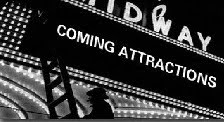
Out of the past and into the present?
The old Clinton campaign war room ran on the mantra, “It’s the economy, stupid.” Now, more than a decade later, we’re back – to a variation of it: it’s the jobs, stupid.
As we all know by now, “The nation's unemployment rate hit 10.2 percent in October, reflecting the economic pain of the 16 million jobless Americans, as well as the strain felt by the 138 million others who are working harder to earn their paychecks.”
From John Batchelor comes the view "that the jobless official rate has now moved above 10% and will remain above 10% as far as Washington can see." The worry inside the Beltway is that regardless of upticks in GDP or consumer spending, it won't be much of a recovery - if at all - without positive employment news.

The architects of 'It's the (fill in the blank), stupid'...
According to The Wall Street Journal, “The U.S. jobless rate jumped up 0.4 percentage point to 10.2% in October, the highest level since April 1983. The government’s broader measure of unemployment shot up even more, rising half a point to 17.5%. The comprehensive gauge of labor underutilization, known as the “U-6″ for its data classification by the Labor Department, accounts for people who have stopped looking for work or who can’t find full-time jobs. Its continuing divergence from the official rate (the “U-3″ unemployment measure) indicates the job market has a long way to go before growth in the economy translates into relief for workers. The U-6 rate is now the highest since the Labor Department started this particular data series in 1994. It likely isn’t as bad as it was in the 1980s, when the headline unemployment rate hit 10.8%. U-6 only goes back to 1994, but a discontinued measure has a longer history. That old U-6 measure peaked at 14.3% in 1982. Through some calculation, a comparable measure can be determined in the current report. Under the old U-6 methodology, the October rate would be 14%, the highest rate since 1982, but still below the peak.”
In California, where unemployment was 12.2% in September, the rate for October will be reported Nov. 20. It is widely believed that the broader measure of unemployment in the Golden State is now hovering near 20%.

What will the Obama-PelosiCare bill mean to jobs and the economy?
Over at The Washington Examiner, Byron York makes this observation: “In the last week, there have been four major events with the potential to dominate news coverage for many, many days: the off-year elections, the Fort Hood shootings, the House passage of Obama-PelosiCare, and the rise of unemployment to 10.2 percent. But the news will always return to unemployment when other topics fade. ‘Any time you have unemployment this high, it is the number one story, whether it's being written about or not,’ says David Winston, a Republican pollster who for months has urged GOP officeholders to focus steadily on the issue. Double-digit unemployment is the default top story of the year; whatever else happens, the national conversation will come back to unemployment as long as the jobless rate remains unacceptably high.”
We’re still ahead of Europe - wait, that's not good: “Unemployment is now higher in the U.S. than in Europe, reports The Washington Post. “The official U.S. unemployment rate, reported last Friday, now stands at 10.2 percent,” compared to “9.7 percent” in Europe. This is the highest rate in more than 26 years, and marks a huge change from the recent past, in which unemployment was double the American rate in much of Europe.”

Nouriel 'Dr. Doom' Roubini: we didn't heed his warnings the first time.
Of course, some people would have you believe we’re now at the beginning of a recovery (even if it is a “jobless recovery”). Unfortunately, there are dark clouds on the horizon. If Nouriel Roubini’s warnings come true (again…and there’s no reason to believe they won’t), the current jobs picture will be just of taste of what’s to come.
Richard Fisher, president of the Federal Reserve Bank of Dallas, in a speech Tuesday said “for now, with U.S. unemployment at its highest level since 1983, the devastated job market remains a huge worry. ‘It will take some time, in my opinion, to get back on a steady pathway to a pace of growth that will result in significant job creation,’ Fisher said. ‘We are in for a long slog.’"
Hopefully, that "long slog" won't turn into a death march for the economy.




No comments:
Post a Comment